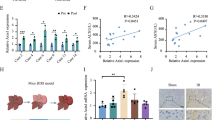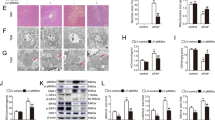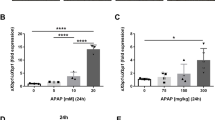Abstract
Acetaminophen (APAP)-induced acute liver injury (AILI) is primarily driven by CYP3A4‒mediated overproduction of the toxic metabolite N-acetyl-p-benzoquinone imine (NAPQI), CYP3A4 activity serves as the rate-limiting determinant of NAPQI accumulation levels. Poly ADP-ribose polymerase 1 (PARP1)-driven ribosylation, a posttranslational modification, has been linked to drug-induced liver injury. PARP1 interacts with pregnane X receptor (PXR), a nuclear receptor that regulates drug-metabolizing enzymes including CYP3A4. In this study we investigated the specific sites of PARP1-mediated PXR ribosylation, particularly regarding their functional relevance to CYP3A4-driven NAPQI biosynthesis in AILI. To establish AILI models, mice were injected with APAP (300 mg·kg-1, i.p.), liver tissues and serum were collected for analysis 24 h post-injection. In vitro study was conducted in primary hepatocytes isolated from AILI mice and in human hepatic L02 cells exposed to APAP (5, 10, 20 μM). We demonstrated that under AILI conditions, PARP1 catalyzed ribosylation of PXR at the residue E194, forming a PARP1–PXR‒CYP3A4 regulatory axis that amplified oxidative stress and NAPQI accumulation through a positive feedback loop. Specifically, PARP1 was significantly overexpressed in AILI models in vivo and in vitro, and its interaction with PXR was confirmed in immunoprecipitation and proximity biotinylation assays. Molecular dynamics (MD) simulations, mass spectrometry and E194A site-directed mutagenesis revealed that PARP1-mediated ribosylation of PXR E194 enhanced CYP3A4 transcription, ultimately leading to excessive NAPQI production. MD simulations also identified a natural compound schisandrin B (Sch B) that specifically bound to the ligand-binding domain of PXR, induced conformational changes and disrupted the PARP1–PXR interaction interface, thus suppressed the ribosylation. In AILI murine models, administration of Sch B (25, 50, and 100 mg·kg−1·d−1, i.g.) for 8 days significantly reduced serum ALT and AST levels, attenuated oxidative stress, and inhibited NAPQI generation by blocking complex formation. This study not only elucidates the mechanisms of PARP1-mediated PXR E194 ribosylation in AILI but also identifies Sch B as the first specific inhibitor of this pathway, providing a theoretical basis for precision detoxification strategies targeting posttranslational modifications.

This is a preview of subscription content, access via your institution
Access options
Subscribe to this journal
Receive 12 print issues and online access
$259.00 per year
only $21.58 per issue
Buy this article
- Purchase on SpringerLink
- Instant access to full article PDF
Prices may be subject to local taxes which are calculated during checkout







Similar content being viewed by others
References
Cedron VP, Weiner AMJ, Vera M, Sanchez L. Acetaminophen affects the survivor, pigmentation and development of craniofacial structures in zebrafish (Danio rerio) embryos. Biochem Pharmacol. 2020;174:113816.
Liu H, Yin G, Kohlhepp MS, Schumacher F, Hundertmark J, Hassan MIA, et al. Dissecting acute drug-induced hepatotoxicity and therapeutic responses of steatotic liver disease using primary mouse liver and blood cells in a Liver-On-A-Chip model. Adv Sci (Weinh). 2024;11:e2403516.
Chilvery S, Yelne A, Khurana A, Saifi MA, Bansod S, Anchi P, et al. Acetaminophen induced hepatotoxicity: An overview of the promising protective effects of natural products and herbal formulations. Phytomedicine. 2023;108:154510.
Fang Z, Xu Y, Liu G, Shao Q, Niu X, Tai W, et al. Narirutin activates TFEB (transcription factor EB) to protect against acetaminophen-induced liver injury by targeting PPP3/calcineurin. Autophagy. 2023;19:2240–56.
Sun Z, Wang Q, Sun L, Wu M, Li S, Hua H, et al. Acetaminophen-induced reduction of NIMA-related kinase 7 expression exacerbates acute liver injury. JHEP Rep. 2022;4:100545.
Zhou Y, Fan X, Jiao T, Li W, Chen P, Jiang Y, et al. SIRT6 as a key event linking P53 and NRF2 counteracts APAP-induced hepatotoxicity through inhibiting oxidative stress and promoting hepatocyte proliferation. Acta Pharm Sin B. 2021;11:89–99.
Gao RY, Wang M, Liu Q, Feng D, Wen Y, Xia Y, et al. Hypoxia-inducible factor-2α reprograms liver macrophages to protect against acute liver injury through the production of interleukin-6. Hepatology. 2020;71:2105–17.
Wang J, Bwayi M, Gee RRF, Chen T. PXR-mediated idiosyncratic drug-induced liver injury: mechanistic insights and targeting approaches. Expert Opin Drug Metab Toxicol. 2020;16:711–22.
Siavashpour A, Khalvati B, Azarpira N, Mohammadi H, Niknahad H, Heidari R. Poly (ADP-Ribose) polymerase-1 (PARP-1) overactivity plays a pathogenic role in bile acids-induced nephrotoxicity in cholestatic rats. Toxicol Lett. 2020;330:144–58.
Mukherjee U, Samanta A, Biswas S, Ghosh S, Das S, Banerjee S, et al. Chronic exposure to nonylphenol induces oxidative stress and liver damage in male zebrafish (Danio rerio): Mechanistic insight into cellular energy sensors, lipid accumulation and immune modulation. Chem Biol Interact. 2022;351:109762.
Langelier MF, Mirhasan M, Gilbert K, Sverzhinksy A, Furtos A, Pascal JM. PARP enzyme de novo synthesis of protein-free poly(ADP-ribose). Mol Cell. 2024;84:4758–73.e6.
Wang C, Xu W, Zhang Y, Huang D, Huang K. Poly(ADP-ribosyl)ated PXR is a critical regulator of acetaminophen-induced hepatotoxicity. Cell Death Dis. 2018;9:819.
Cui W, Cao Q, Liu L, Yin X, Wang X, Zhao Y, et al. Artemisia Argyi essential oil ameliorates acetaminophen-induced hepatotoxicity via CYP2E1 and γ-glutamyl cycle reprogramming. Phytomedicine. 2024;135:156106.
Li X, Zhao Y, Gong S, Song T, Ge J, Li J, et al. Schisandrin B ameliorates acute liver injury by regulating EGFR-mediated activation of autophagy. Bioorg Chem. 2023;130:106272.
Fan X, Elkin K, Shi Y, Zhang Z, Cheng Y, Gu J, et al. Schisandrin B improves cerebral ischemia and reduces reperfusion injury in rats through TLR4/NF-κB signaling pathway inhibition. Neurol Res. 2020;42:693–702.
Zhang W, Wang W, Shen C, Wang X, Pu Z, Yin Q. Network pharmacology for systematic understanding of Schisandrin B reduces the epithelial cells injury of colitis through regulating pyroptosis by AMPK/Nrf2/NLRP3 inflammasome. Aging (Albany NY). 2021;13:23193–209.
Xu Y, Xia Y, Liu Q, Jing X, Tang Q, Zhang J, et al. Glutaredoxin-1 alleviates acetaminophen-induced liver injury by decreasing its toxic metabolites. J Pharm Anal. 2023;13:1548–61.
Cao J, Su B, Zhang C, Peng R, Tu D, Deng Q, et al. Degradation of PARP1 by MARCHF3 in tumor cells triggers cCAS-STING activation in dendritic cells to regulate antitumor immunity in hepatocellular carcinoma. J Immunother Cancer 2024;12:e010157.
Keggenhoff FL, Castven D, Becker D, Stojkovic S, Castven J, Zimpel C, et al. PARP-1 selectively impairs KRAS-driven phenotypic and molecular features in intrahepatic cholangiocarcinoma. Gut. 2024;73:1712–24.
Luo J, Liu H, Xu Y, Yu N, Steiner RA, Wu X, et al. Hepatic Sirt6 activation abrogates acute liver failure. Cell Death Dis. 2024;15:283.
Pan D, Yang W, Zeng Y, Qin H, Xu Y, Gui Y, et al. AKR1C3 regulated by NRF2/MAFG complex promotes proliferation via stabilizing PARP1 in hepatocellular carcinoma. Oncogene. 2022;41:3846–58.
Yang X, Li G, Lou P, Zhang M, Yao K, Xiao J, et al. Excessive nucleic acid R-loops induce mitochondria-dependent epithelial cell necroptosis and drive spontaneous intestinal inflammation. Proc Natl Acad Sci USA. 2024;121:e2307395120.
Abdellatif A, Bahria K, Slama N, Oukrif D, Shalaby A, Birkmayer G, et al. NADH intraperitoneal injection prevents massive pancreatic beta cell destruction in a streptozotocin-induced diabetes in rats. Histochem Cell Biol. 2024;161:239–53.
Sun YF, Pan HH, Xia ZN, Yu ZM, Li CL, Wang XD, et al. Alisma Shugan Decoction attenuates hepatic fibrosis and endoplasmic reticulum stress in mice with carbon tetrachloride-induced fibrosis. Afr Health Sci. 2023;23:422–34.
Hu J, Sun J, Zhong Q, Chen S, Yin W, Wei X, et al. Edgeworthia gardneri (Wall.) Meisn Mitigates CCl4-induced liver injury in mice by modulating gut microbiota, boosting antioxidant defense, and reducing inflammation. Ecotoxicol Environ Saf. 2025;293:118042.
Szántó M, Gupte R, Kraus WL, Pacher P, Bai P. PARPs in lipid metabolism and related diseases. Prog Lipid Res. 2021;84:101117.
Liao C, Zhang L, Jiang R, Hu D, Xu J, Hu K, et al. Nicotinamide adenine dinucleotide attenuates acetaminophen-induced acute liver injury via activation of PARP1, Sirt1, and Nrf2 in mice. Can J Physiol Pharmacol. 2022;100:796–805.
Hall A, Chanteux H, Ménochet K, Ledecq M, Schulze MED. Designing out PXR activity on drug discovery projects: a review of structure-based methods, empirical and computational approaches. J Med Chem. 2021;64:6413–522.
Cui Q, Jiang T, Xie X, Wang H, Qian L, Cheng Y, et al. S-nitrosylation attenuates pregnane X receptor hyperactivity and acetaminophen-induced liver injury. JCI Insight. 2024;9:e172632.
Chen Y, Cui T, Xiao S, Li T, Zhong Y, Tang K, et al. Hepatic ZBTB22-mediated detoxification ameliorates acetaminophen-induced liver injury by inhibiting pregnane X receptor signaling. iScience. 2023;26:106318.
Zhou Z, Qi J, Zhao J, Seo JH, Shin DG, Cha JD, et al. Orostachys japonicus ameliorates acetaminophen-induced acute liver injury in mice. J Ethnopharmacol. 2021;265:113392.
Kamaraj R, Pavek P. Novel antagonists reveal the mechanism of PXR inhibition. Trends Pharmacol Sci. 2024;45:961–3.
Kim JS, Jegal KH, Park HR, Choi BR, Kim JK, Ku SK. A mixture of fermented Schizandrae Fructus Pomace and Hoveniae Semen cum Fructus extracts synergistically protects against oxidative stress-mediated liver injury. Antioxidants (Basel). 2023;12:1556.
Xue L, Liu K, Yan C, Dun J, Xu Y, Wu L, et al. Schisandra lignans ameliorate nonalcoholic steatohepatitis by regulating aberrant metabolism of phosphatidylethanolamines. Acta Pharm Sin B. 2023;13:3545–60.
Wang HQ, Wan Z, Zhang Q, Su T, Yu D, Wang F, et al. Schisandrin B targets cannabinoid 2 receptor in Kupffer cell to ameliorate CCl4-induced liver fibrosis by suppressing NF-κB and p38 MAPK pathway. Phytomedicine. 2022;98:153960.
Liu SQ, Yang YP, Hussain N, Jian YQ, Li B, Qiu YX, et al. Dibenzocyclooctadiene lignans from the family Schisandraceae: A review of phytochemistry, structure-activity relationship, and hepatoprotective effects. Pharmacol Res. 2023;195:106872.
Acknowledgements
The graphical abstract was created with BioRender.com.
Funding
The authors would like to acknowledge the support of the National Natural Science Foundation of China (Grant Nos. 82274214 and 82322074), the Research Foundation of the Educational Bureau of Guangdong Province (Grant No. 2022ZDZX2010), and the Guangdong Key Laboratory for Translational Cancer Research of Chinese Medicine (Grant No. 2023B1212060061).
Author information
Authors and Affiliations
Contributions
JCL and CXL performed the experiments; LA, MYW and CHL designed the project and revised the paper; JCL, CXL, MYW, and CHL performed the informatics analysis and experiments; JCL, CXL, LA and CYW wrote the paper. FZ, ZQL, LA, and CYW acquainted funding and supervised the study. All the authors read and approved the final paper.
Corresponding authors
Ethics declarations
Competing interests
The authors declare no competing interests.
Additional information
Publisher’s note Springer Nature remains neutral with regard to jurisdictional claims in published maps and institutional affiliations.
Rights and permissions
Springer Nature or its licensor (e.g. a society or other partner) holds exclusive rights to this article under a publishing agreement with the author(s) or other rightsholder(s); author self-archiving of the accepted manuscript version of this article is solely governed by the terms of such publishing agreement and applicable law.
About this article
Cite this article
Long, Jc., Liu, Cx., Wang, My. et al. PXR ribosylation at E194 amplifies NAPQI in acetaminophen‒induced liver injury in mice, rescued by Schisandrin B. Acta Pharmacol Sin (2025). https://doi.org/10.1038/s41401-025-01632-5
Received:
Accepted:
Published:
DOI: https://doi.org/10.1038/s41401-025-01632-5



